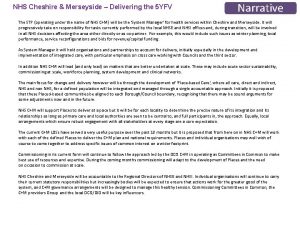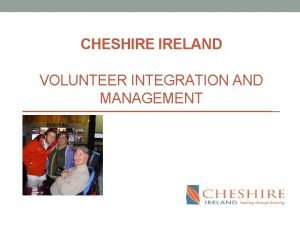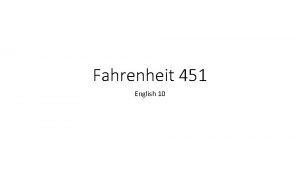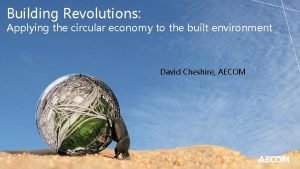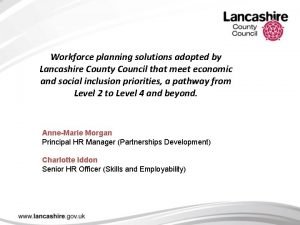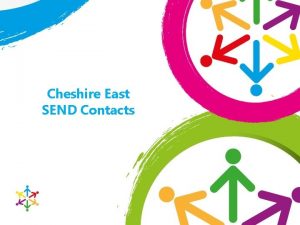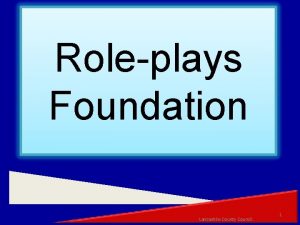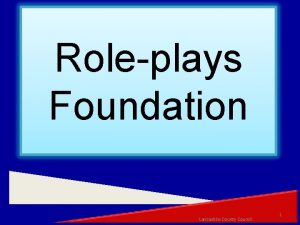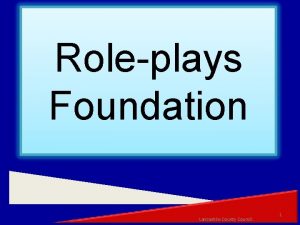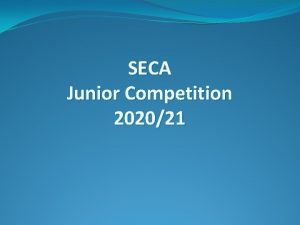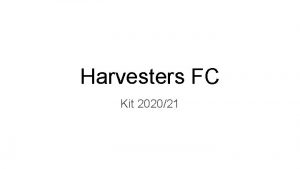Cheshire to Lancashire Area Team Plan 202021 An











- Slides: 11

Cheshire to Lancashire Area Team Plan 2020/21

An Introduction to the Cheshire to Lancashire Team Our patch is one of great contrast; 6 million people living among magnificent landscapes including the Pennine and Bowland Hills, the wetlands of Cheshire and Greater Manchester and the Irish Sea coast between Liverpool and Morecambe. Our expansive ‘blanket bog’ moors, our lowland meres and mosses and our estuaries and bays are of international importance for birds and other wildlife, all thriving close to our towns and cities. We’re here to conserve and enhance these natural assets and ensure they contribute to a healthy, prosperous place to live and work. Building on progress from previous years, we will focus out efforts in 2020 on three visions that will, in turn, help deliver Natural England’s Five Year Action plan • Create a Nature Recovery Network of wetlands through Cheshire and Greater Manchester for wildlife and for people • Create a flourishing uplandscape in Bowland the West Pennine Moors that is a source of pride, rural employment, access and enjoyment. Secure a safe home for birds such as hen harrier and merlin as well as benefits to water quality, flood management and climate change. • Use innovative sustainable development, natural capital and nature based solutions to develop a ‘Blue Belt’ (coast and marine) Nature Recovery Network between Liverpool and Morecambe. Our organisational values will be reflected in our culture and ways of working. We aim to be an efficient, safe, and happy team, supporting each other and collaborating with partners to create a better environment. Ginny Hinton, Area Manager

Who we are: How our team is structured Ginny Hinton (Area Manager) • Amanda Yeomans (Team Leader) Dave Bell (Manager) Lucy Abram (Manager) Andy Clements (Board Member) • Liz Hopley (Team Leader) Innovation and Support Team Coast and Marine Team Uplands & Farmland Conservation Urban, Water and Wetlands • Sam Critchley (Team Leader) NNR Team (Mike Downey / Dave Mercer) • Petula Neilson (Team Leader) CSF Team (Rachael Garnett)

How we work NE Values We are ambitious • We are bold, influential and focussed on delivering our vision and mission • We encourage and inspire each other to innovate, leading by example to encourage and inspire others to act • We are positive and celebrate our successes and those of our partners We act with integrity • We are a professional knowledge and evidence-based organisation • We explain the reasons behind our decisions and our work • We take appropriate action, using all available tools, to protect the natural environment • We earn trust by being objective and open in our decisions and clear on the outcomes to be achieved We are collaborative We are inclusive • We build and nurture • We care about our people and partnerships, working across their wellbeing internal teams and with external • We treat each other with partners to deliver our vision for respect externally and people and planet internally • We share our expertise and strive • We aim to be representative of for excellence our community and we reach • We listen and learn to out to a diverse range of continuously improve together partners • We welcome diversity of thought and challenge that seeks the best outcomes C 2 L Team Culture * Knowledge * Share it * Support * Give it * Excellence * Reach for it * Individuality * appreciate it Building A Great Team Culture * Respect * Earn it & show it * Intergrity * Show it * Team work * Embrace it

Our team priorities for 20/21: Resilient Landscapes and Seas 1. Integrate 25 YEP delivery in Greater Manchester around a shared Nature Recovery Network. Delivering this through a mixture of GIA and externally funded projects (eg Natural Course) 2. Dynamic Dunescapes project develops a strong NRN based on species recovery and increasing biodiversity resilience on the coast 3. Our coastal NNRs act as a living lab for the North West region, showcasing and furthering best practice in habitat management and access/engagement. Work Area Activity Nature Recovery Networks Convene and enable local partnerships to identify and develop their own nature recovery networks. Ensure Protected Sites on land sea are well managed and central to driving nature recovery. Site monitoring: GIA-funded evidence gathering, and sharing evidence with land managers/partners. Develop and publish the Marine conservation advice packages. Progress MPA condition assessment programme. Designated Landscapes Strategic advice including historic and geodiversity to support designated landscapes to deliver Glover ambition. Promote NNRs as a catalyst for inspiring people about nature, to enjoy it and care for it. Deliver NNR strategy ensuring we adopt legal practices and our NNRs are safe places for workers and visitors. Enable large scale land use change for carbon capture through the NRN that delivers multiple public benefits. Advice on finalisation of Defra Peat Strategy. Plan and prioritise peat restoration projects across lowland upland peatland, taking a proactive approach at hydrological, rather than landowner, scale. Shape our species recovery and reintroductions strategy and delivery to underpin the restoration of ecosystem processes. Dynamic Dunescapes Natural Course RLS

Our team priorities for 20/21: Greener Farming and Fisheries GFF 1. Protecting our Upland Peatland resource through targeted peat management projects (Carbon Peat Pilot, Rush Management and Defra Peat Strategy) and long term management plans 2. Joint working with Cumbria AT to facilitate positive relationships for coastal activities and positive change in the Irish Sea 3. Increase Area Team knowledge in preparation for NELMs Work Area Activity Agri-Enviornment Schemes Maintain and enhance existing scheme outcomes through the delivery of new HT agreements, HLS extensions and an agreed transition plan. SSSI Regulation Casework Protected Sites reactive casework consents, assents, advice excluding land-use planning and marine) Uplands Programme Enforcement SSSI Regulation casework activity, EIA (Agriculture) Regs & Weeds Act Catchment Sensitive Farming Regional advice (including MT endorsements) Clean Air & Water Price Review 19/24 (water company assets and investigations) Diffuse Water Pollution Judicial Review Consent Order Strategic water planning MPAs Provide regulators with and aquaculture advice to deliver GES and well managed MPAs.

Our team priorities for 20/21: People and Nature P&N 1. Our coastal NNRs act as a living lab for the North West region, showcasing and furthering best practice in habitat management and access/engagement. 2. Increase our ability to influence strategic policies, partnerships and decision-making at all levels across our Area to achieve better outcomes for people and nature 3. [Aspirational Priority if funding available] Staff embedded in Regional Social Prescribing partnerships Work Area Activity Connecting People with Nature Expand volunteering as a means to deliver favourable condition, species recovery, landscape scale delivery, climate change mitigation and improvement of degraded environments by working with sector partners and targeted local communities Engaging the pubic in our species recovery work through Dynamic Dunescapes and Natural Course

To have a coast and marine Nature Recovery Network with statutory sites providing a protected and well managed core. Coast and Marine Team Sustainable Development Greener Farming and Fisheries Resilient Landscapes & Seas People &Nature £ Commercial Goal Tools Be instrumental in forming or guiding partnerships to deliver coastal and marine Nature Recovery Networks to recover biodiversity, grow our natural capital assets and deliver nature based solutions to provide improved ecosystem services. Partnership working – work with range of partners and partnerships eg Local Nature Partnerships (LCR, Lancs and Morecambe Bay) to facilitate a NRN Partnerships to establish and develop NRNs Evidence – Use our evidence work to support NRN evidence needs Statutory duty – use our statutory duty, advice and regulatory role to support NRN development Improve condition of statutory protected sites (coastal and marine) as core sites for nature recovery networks. Includes proactive and statutory delivery of protected sites role, National Nature Reserve core function and Dynamic Dunescapes HLF/LIFE project. Partnership working Active participation in key coastal partnerships for Morecambe Bay, Ribble Estuary and Sefton Coast Direct and partnership delivery of NNR Management Plans for conservation, research and people engagement Use of external funding (eg Dynamic Dunescapes) and income £ Use of external and internal evidence, site checks and monitoring Public engagement – Through Dynamic Dunescapes ECP to improve sustainable access and provision of mitigation Achieve coastal and marine Sustainable Development (including Net Gain) to protect and enhance our natural assets as part of Nature Recovery Networks; includes statutory advice and development of strategic solutions eg for recreational disturbance. Work with range of partners/sectors eg developers, planners, land owners and tourism. Use of statutory advice and DAS into strategic plans (eg LCR SDS, Local Plans, Marine Plan, AONB plans, Shoreline Management Plan) and higher risk £ casework. Use of Net Gain, planning agreements and District Level Licencing (Lancs) Use of tools such as IRZ, Conservation advice and coastal concordat with EA and MMO Team working – especially with IST to deliver BAU element of goal Partnership working and collaboration - to improve evidence, deliver mitigation and monitor success Team working to ensure SD activity contributes to the other goals Evidence - Increase knowledge across AT and with partners Monitoring of success of enhancements and mitigation Improve ecological functionality of land outside protected sites to support Nature Recovery Networks eg improvement of Functionally Linked Land. Evidence – improve understanding of what’s used and what’s required Agri-environment schemes – review value of current agreements and target use of new agreements (High and Mid Tier) Use of tools such as IRZ, District Level Licencing, Net Gain, planning agreements etc

Uplands & Farmland Conservation Create flourishing uplandscapes that are a source of pride, rural employment, access and enjoyment. These mosaics of habitats will provide benefits to biodiversity, water quality, flood management, climate change and the wider farmed environment. We want to secure a safe home for threatened birds such as hen harrier and merlin plus the many other upland birds that use the landscape for breeding and feeding. Sustainable Development Greener Farming and Fisheries Resilient Landscapes & Seas People &Nature £ Commercial Goal Tools Improving the quality and functionality of all designated features on West Pennine Moors SSSI and Bowland Fells SSSI/SPA Consenting, assenting and regulation – statutory casework, advice on the HARP project, EIA and enforcement Evidence and monitoring (site checks and monitoring) Partnership working – scope potential projects and explore external funding options. Working with our partner organisations across the Uplands to ensure better nature for more people through collaborative working and knowledge sharing. Influencing land managers to implement positive management of the uplands and the wider farmed landscape Partnership working – AMP 7/PR 19, Lancs Peat Partnership Input into Uplands Long Term Management Plans Stakeholder engagement – AONB, UU, Estates, RSPB Protecting the peatland resource, in particular securing appropriate management of blanket bog (with particular scrutiny of the use of burning and cutting) Project working – carbon peat project, rush project, DEFRA peat strategy

Urban, Water and Wetlands To create a resilient and coherent Nature Recovery Network of wetlands through Cheshire and Greater Manchester that provides habitat for wildlife and accessible greenspace for people to value and use. Sustainable Development Greener Farming and Fisheries Resilient Landscapes & Seas People &Nature £ Commercial Goal Tools Transforming the way we work to deliver water quality improvements and wetland enhancements across Cheshire, GM and the NW River Basin catchment. Natural Course EU life project including deliverables C 10 & C 18. Development of Cheshire Hub for water delivery including a Northern Meres Catchment Plan. Collaborative working across Natural Course Partners including deliverables A 6 & A 7 Taking a Natural Capital approach to farm planning, developing a replicable approach through Natural Course case studies. Deliverable C 10. CSF and Agri-environment integrated delivery targeted at core outcomes Diffuse Water Pollution Judicial Review. Integrate Nature Recovery Networks Continuing development of the evidence base though the delivery of Natural Course EU Life project deliverable C 18, developing woodland fluvial modelling to build on into local planning and decision-making and enhance the existing wetland model. Joining-up 25 YEP delivery in Greater Manchester. Making a radical impact on environmental delivery in and around urban areas. Targeted engagement in policy and strategic planning documents in Greater Manchester and Cheshire. Major transport infrastructure including HS 2, Transport for the North and Transport Authorities all make an active contribution to our Nature Recovery Network. Creating Genuine Sustainable Development Biodiversity Net Gain delivered across Greater Manchester and promoted across Cheshire District Level Licensing delivered in Cheshire and Greater Manchester Proactive engagement on strategic Local Plans and GMSF across the area to ensure that NRN’s, Peat, Air Quality, Recreational Disturbance are all considered at policy level together with supporting sound legally compliant HRA’s. Delivering Lowland Peat Restoration through working in partnership across GM and Cheshire. £ Active participation in the Great Manchester Wetlands Partnership (NIA) and Carbon Landscape Project. Developing the next phase of the Peat Pilot work, addressing the carbon impacts of the evidence base on peat that has not been properly managed. Priority Agri Environment agreements to bring peat into appropriate management. Developing the case for paludiculture through pilots. Working with SSSI owners across Cheshire Meres & Mosses and Manchester Mosses to work towards favourable condition. Secure external funding and Defra Peatland funding. £

Working in Partnership to delivery Thriving Nature for People and the Planet Partnership is key to delivering our Area Team Plan We will focus on increasing our ability to influence strategic policies and partnerships. We will do this by: 1. Supporting existing partnerships and investing in new and broader sector partnerships where they support our team goals 2. Demonstrating how our expertise will support shared goals 3. Increasing knowledge and awareness of new policy and delivery mechanisms such as Nature Recovery Networks, Net Gain, District Level Licensing, and Local Nature Recovery Strategies 4. Developing influencing skills throughout the team as part of our learning and development plan
 Cheshire and merseyside training hub
Cheshire and merseyside training hub The trickster jung
The trickster jung Cheshire and merseyside stp
Cheshire and merseyside stp Sweet food of sweetly uttered knowledge
Sweet food of sweetly uttered knowledge Cheshire ireland pay scale
Cheshire ireland pay scale Why does montag plant the book at black's house
Why does montag plant the book at black's house Cheshire constabulary
Cheshire constabulary Cheshire golf union
Cheshire golf union David cheshire aecom
David cheshire aecom St claret school barrackpore
St claret school barrackpore Workforce planning solutions
Workforce planning solutions Borrick hall
Borrick hall


